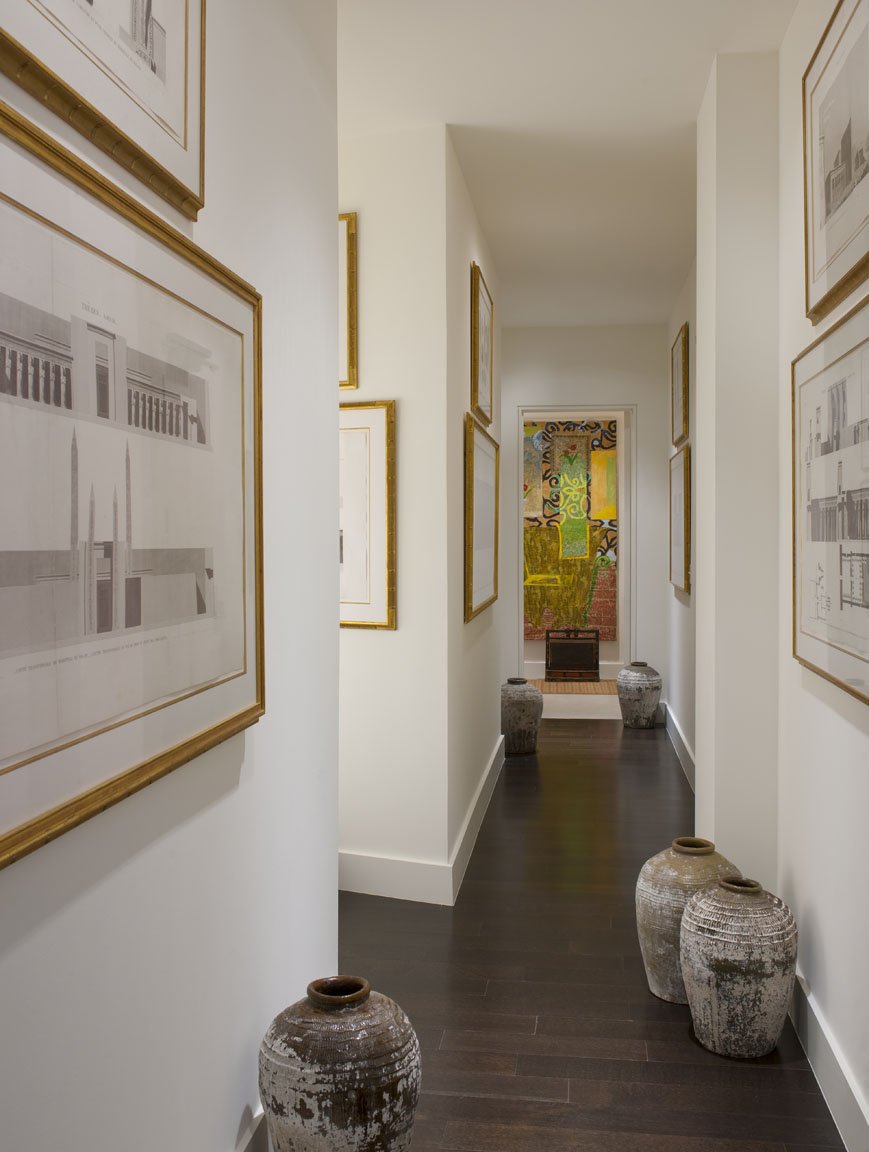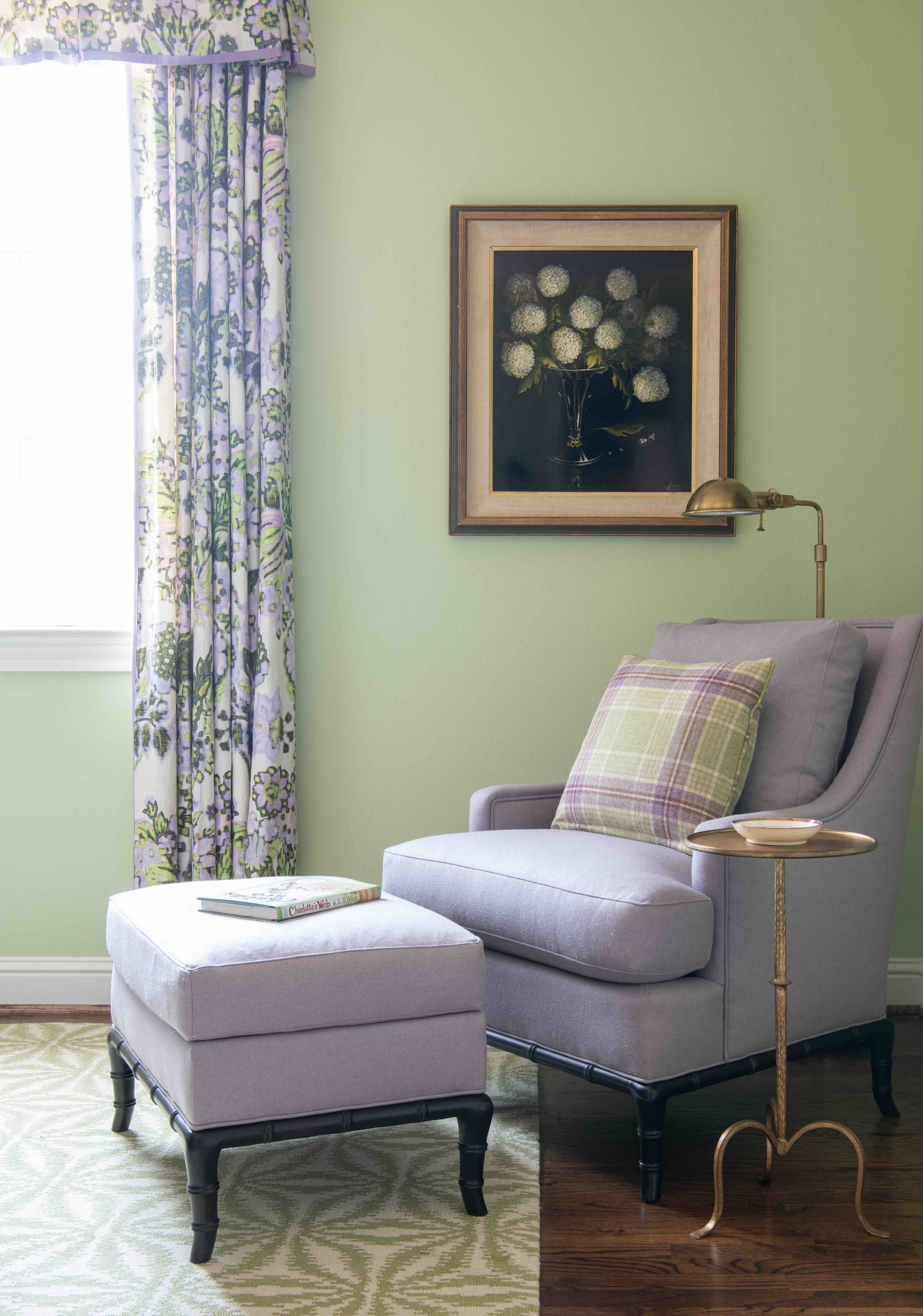The vaulted ceiling in this Dallas home game room called for extra-large light fixtures.
Do you have a room in your home that you feel “stuck” on? Maybe you have an awkwardly shaped space with unused corners. Or perhaps you made a major purchase, like a dining table, that doesn’t mesh with the surrounding décor like you hoped.
When a client calls me, it’s usually because they’re stuck and afraid to make big decisions. As an interior designer, I like to take the following steps whenever I’m confronted with a challenging room.
Step 1: Make a list of what bothers you the most
Long hallways can be challenging to decorate. We filled these walls with a series of gold-framed antique Egyptian prints.
Take a moment to ask yourself if there are things in the room that you already know aren’t working for you and your family’s lifestyle. Then, put away the majority of your accessories, leaving just your largest pieces of furniture and anything else that you’re absolutely sure you want to work with. Paring a room down to its essentials is one way to encourage you to look at the space in a new light.
If the room feels “off” but you still can’t pinpoint the problem, try taking a photo or a video of the room. There are times where seeing the space in a photo can help you identify imbalances or problem areas that you may have overlooked in real life.
Step 2: Study rooms you love for ideas
At this stage, you’ll probably need some ideas on how to work with your mostly-blank slate. Whenever I’m having trouble with a room, I start looking through magazines and home decorating books for inspiration. I also ask my client to show me their favorite rooms so that I can make sure my design aligns with their tastes.
Although the unusual color combination in these curtains created limitations to work with, we were thankfully able to build a beautiful color scheme around them.
A piece of artwork, a fabric pattern, or something from nature can sometimes give me an idea for a color scheme. In one project I designed in Preston Hollow, the client asked me to use six fabric panels she inherited from her mother. The purple, green, and black colors on the panels created limitations to work with, but they also helped define the colors for the rest of the room. For example, we added a still life and a portrait that belonged to the client’s family, both of which had a lot of black in them. This guest bedroom, with its green wall paint color, purple chair, and black-washed night stands, ended up being one of my favorite spaces in the house.
Step 3: Experiment with pieces you already own
Before you run out to a home goods store, try “shopping at home” first. Take items from other rooms and put them in the blank areas of your problem room. You might be surprised to find that a console from your entryway or a painting from the living room looks even better in a new space.
Don’t be afraid to rearrange furniture into new configurations. After moving furniture around, you should be able to figure out what you can work with, and what will need to be replaced, repainted, or reupholstered.
Step 4: Identify your unique style, and only shop for items that fit it
If you own a lot of multicultural art, you can keep things cohesive by combining pieces that share similar colors.
Sometimes when a room isn’t coming together, it’s because it is filled with heirlooms from different design eras. Now’s the time to decide on what style you want to aim for and buy items that fit consistently into it.
Generally, if you’re going to invest in a new anchor piece, it should be timeless—preferably in a neutral color. Your tastes will evolve as trends change, so you don’t want to splurge on a “trendy” piece and have to replace it again a few years later.
If you’re still having trouble getting your room to look perfect, the next step is to bring in a fresh set of eyes. Have a relative or friend stop by. They might be able to identify the missing piece in your room’s equation. Even better, call in a professional designer. As a designer, I actually enjoy working with my clients’ most challenging rooms. Designing a room is like solving a three-dimensional puzzle, and challenging circumstances often result in the most unique and memorable room in the house. You can reach out to us by calling our Dallas office at 214-232-950 or emailing us at info@chambersinteriors.com.
To fill the high ceiling in this stairway hall in a Dallas home, we used framed, eight-foot-tall wallpaper panels.





